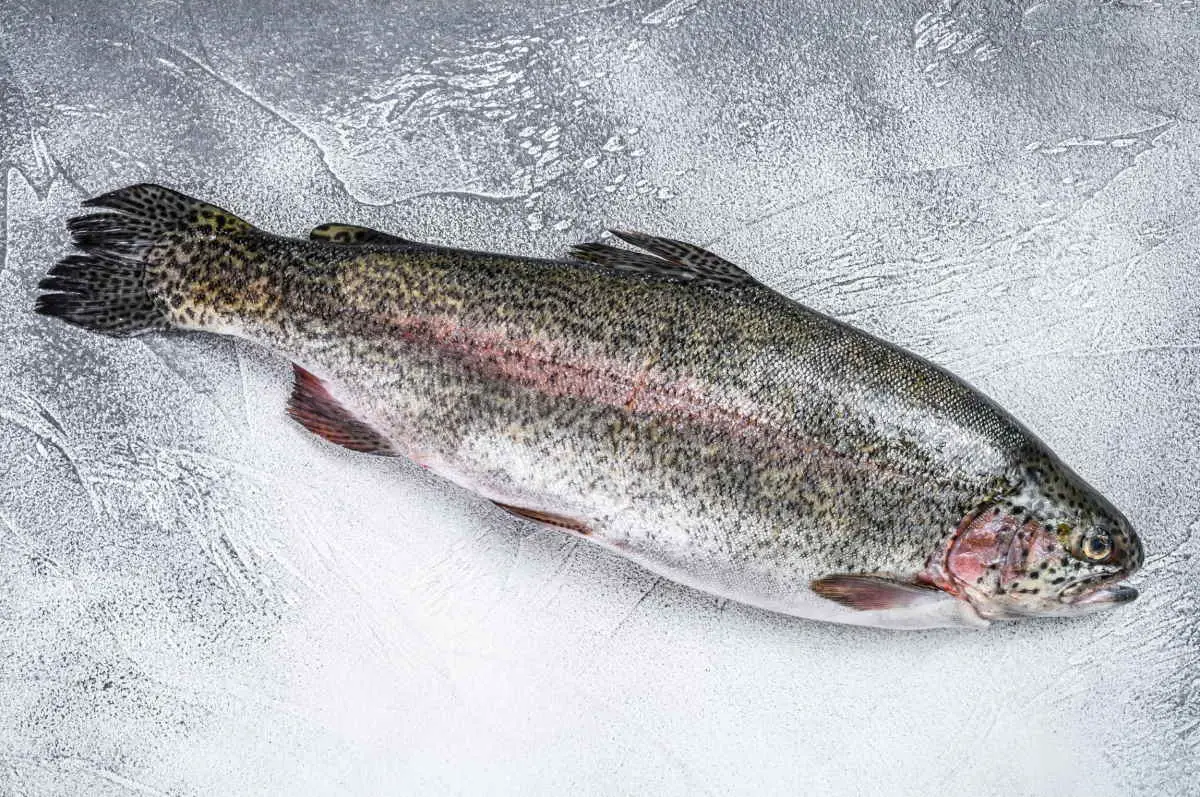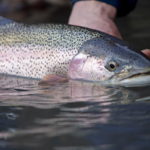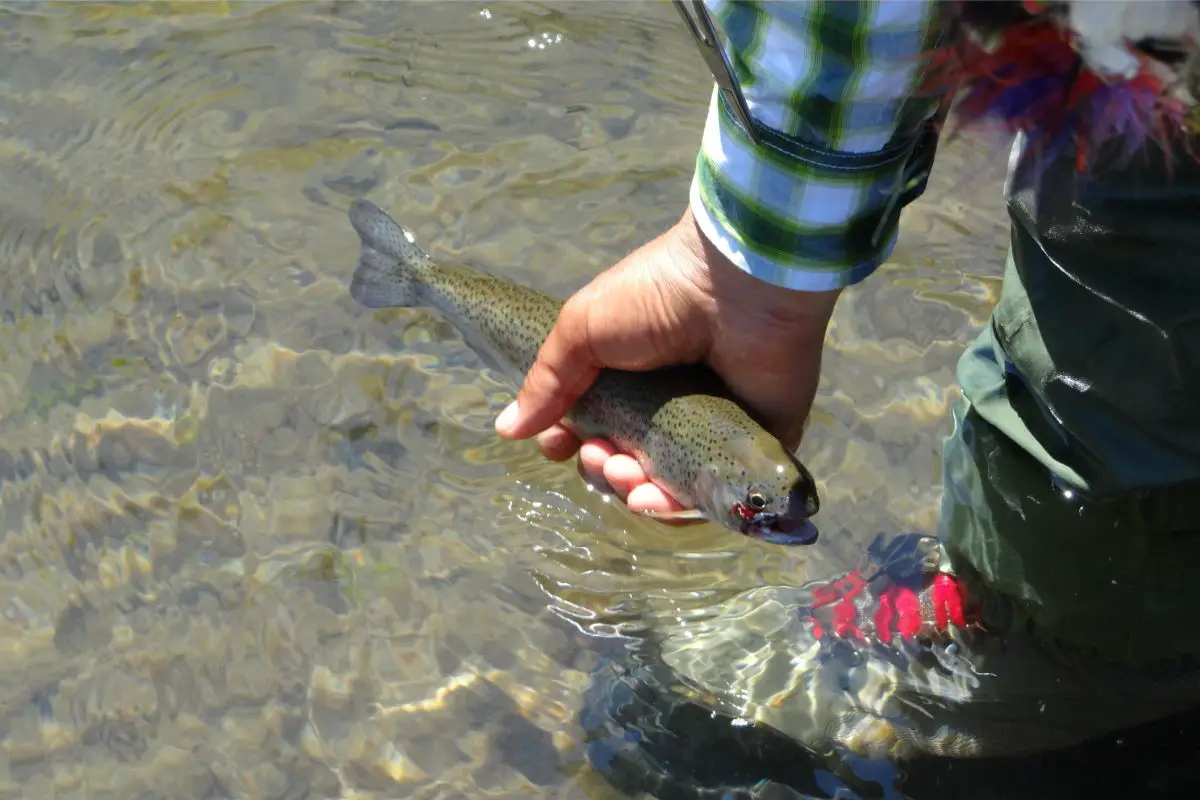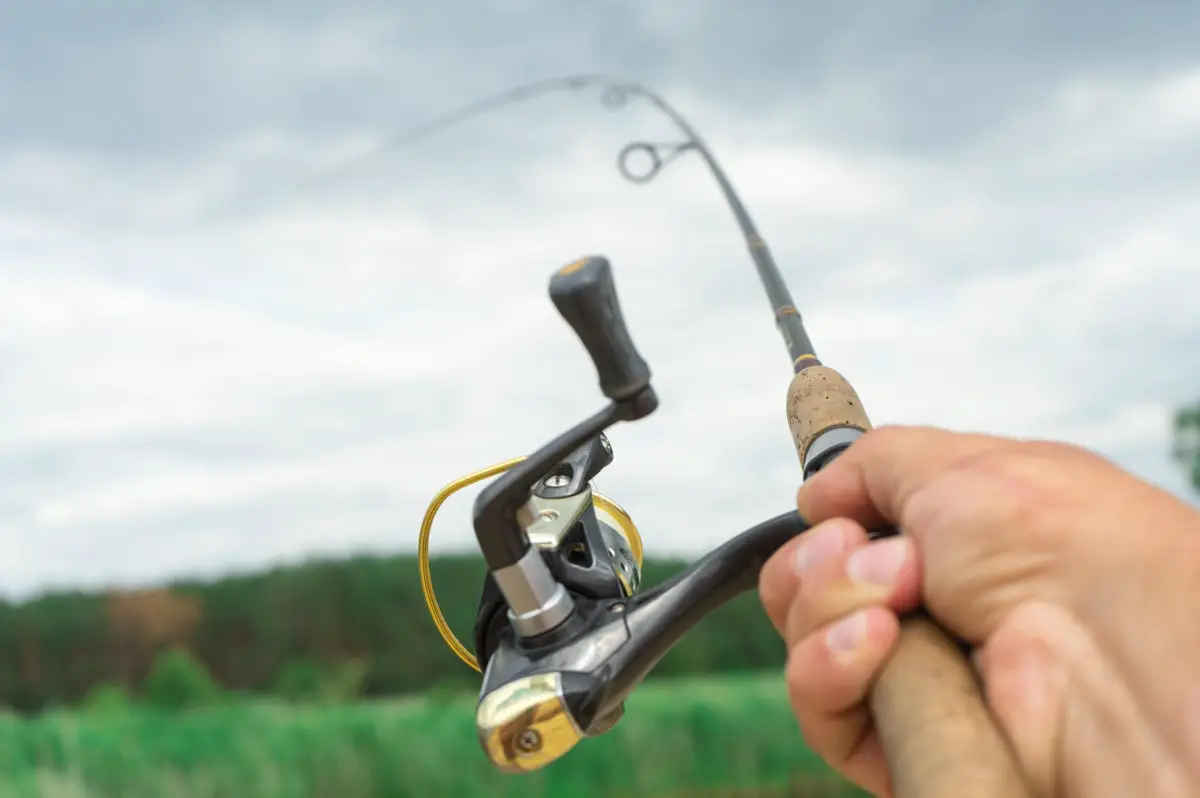Rainbow trout is a popular fish species you’re sure to find all across North America. You can find them in ponds, streams, and rivers. Anglers encounter rainbow trout of different sizes daily, but how big can they get overall?
The average rainbow trout can grow up to 16” (40.64 cm) long and weigh 8 lbs (3.63 kg). The exact weight is often determined by genetics and the fish’s immediate environment. Anglers around the country occasionally catch rainbow trout that’s well beyond the size and weight.
Rainbow trout’s popularity makes the species a target for anglers seeking a trophy catch. The rest of the article will cover all you need to know about rainbow trout size.
The Average Size of Rainbow Trout
A fully mature rainbow trout will weigh 2-8 lbs (0.91-3.63 kg) and grow to around 16” (40.64 cm) in length.
Many anglers will be ecstatic to land a catch nearer the top of the range. In reality, you’re more likely to catch one closer to the bottom of the range, especially if you only fish in small water bodies.
Rainbow trout size is typically consistent in any specific water body. If no large catch has been recorded in the environment, you’re unlikely to ever find any record-breaking catches there.
What Is the World Record Largest Rainbow Trout?
According to the International Game Fish Association’s (IGFA) record book, the world record largest rainbow trout is the 48 lbs (21.77 kg) catch by Canadian fisherman Sean Konrad. The fish was 42” (106.68-cm) long.
The record-breaking rainbow trout was caught in Canada’s Lake Diefenbaker. The lake, a reservoir for the South Saskatchewan and Qu’Appelle rivers, spans 110,000 acres (44,515.42 hectares).
The lake was also the site of the previous world record catch, held by Sean Konrad’s brother Adam.
There’s some controversy around the record. Some triploid rainbow trout engineered to grow extra big escaped from a nearby farm and populated the waters. Therefore, many in the angling community have refused to treat the catch like a wild one.
However, the IGFA’s recognition of the catch means that it remains the world record to date.
Update: An article on the Field and Stream website is reporting an unofficial California record catch. Check the article on their website by clicking this link.
Do Different Types of Rainbow Trout Grow to a Different Size?
Rainbow trout fishes typically don’t grow to different sizes. However, steelheads and triploids may grow to different sizes if the conditions are favorable. Steelheads are technically the same fish as rainbow trout, so it’s common for one to be mistaken for the other.
Steelheads differ from rainbow trout because they migrate back and forth from freshwater to the ocean.
They only return to rivers and streams to spawn, but they feed on the food sources available in the ocean for most of their adult lives. With food undoubtedly more plentiful in the ocean, steelheads often grow to a different size compared to rainbow trout.
You may not land a steelhead while fishing in streams and rivers, but when you do, it’s likely going to qualify as a trophy catch. Rainbow trout weigh less than 8 lbs (3.63 kg) on average, while fully mature steelheads are typically around the 10 lbs (4.54 kg) range.
Triploid rainbow trout are genetically different variants with three sets of chromosomes instead of two. However, there’s still some debate on whether triploid rainbow trout have a weight advantage over their diploid counterparts.
The Idaho Department of Fish and Game compared both and found that they’re typically the same size with an insignificant difference.
However, some proponents of sterile fish farming have insisted that triploids often grow larger. They claim that since the difference in the chromosome makes the fish infertile, all its reproductive energy is rerouted towards growth.
A study comparing all-female triploids to all-female diploids noted that the former grows larger than the latter. The all-female comparison was necessary because male triploids produce gonads which will skew the results.
A similar study found that triploids grow slowly in the early days but eventually catch up with their diploid counterparts.
While the debate rages on, it’s interesting to remember that the two record catches by the Konrad family are triploids. While there’s no conclusive evidence on how or why triploid rainbow trout grows larger than diploid variants, it can’t be ignored.
Does Rainbow Trout Size Depend on the Location?
Rainbow trout size depends on the location. The size of the environment and the available food sources are important determinants for the final size of a rainbow trout. It’s unrealistic to expect to find record-breaking trout in a mountain stream.
If you’d like to find trophy-sized rainbow trout, you’d have to fish in lakes, reservoirs, rivers, and large creeks. Such environments are more conducive to the growth of larger fish.
Similarly, the food sources available in an environment are big determinants of how big rainbow trout can get. You’re likely to find outsized specimens if the water body has many high-protein food sources. A favorite delicacy of rainbow trout is freshwater shrimp.
If the water has a healthy population of these, the fish will likely grow to impressive sizes.
In places like Canada or Alaska, aquatic insects are not the main food source for rainbow trout. Instead, they’ve adapted to eat rodents and small animals that fall into the water or swim across their way. Some of them hunt other smaller fish species.
The trout in these places are likely to be some of the biggest you’d find, crossing the 20” (50.8 cm) boundary and weighing more than 5 lbs (2.27 kg).
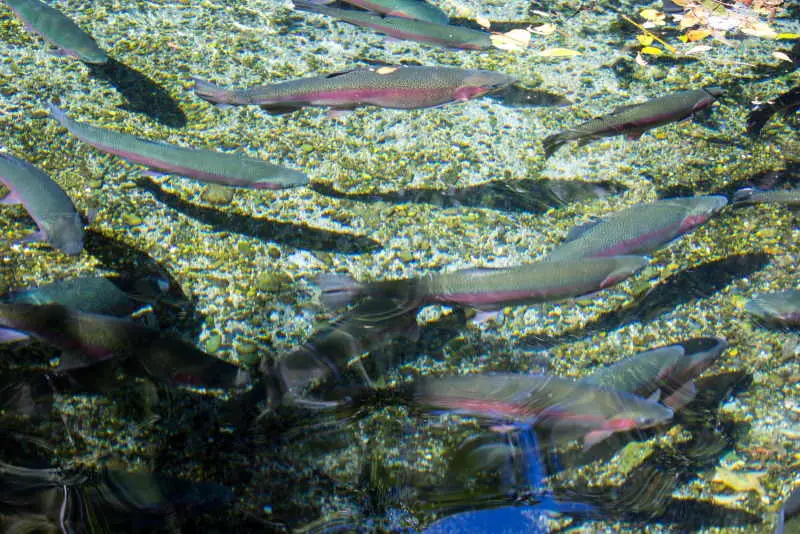
Does Age Affect How Big a Rainbow Trout Can Get?
Age doesn’t affect how big a rainbow trout can get. Most rainbow trout grow to their full adult size within a year but can continue to grow. The size they attain is a function of the food they can consume versus the energy to must expend to obtain the food.
Rainbow trout fed in a large farm will likely be bigger than one fending for itself in a small river.
Similarly, steelheads that make the trip to the ocean will always be larger overall. So, regardless of whether you caught a two or ten-year-old rainbow trout is insignificant to the weight conversation.
When’s the Best Time To Fish for Rainbow Trout?
The best time to fish for rainbow trout is early morning and late afternoon. For the best results, start fishing just before sunrise until two hours after the sun comes up or three hours before sunset until dusk.
Rainbow trout are active during these periods because they have good vision for low-light conditions.
They can see a better contrast of color in reduced light, and their depth of perception is better overall. A combination of these factors gives them a significant advantage over insects and other food sources that can’t see well enough in these conditions.
Top Tips for Catching a Trophy Rainbow Trout
If you’d like to add your name to the record books for rainbow trout fishermen, here are a few things you should do:
- Always fish at the optimal times. We’ve mentioned low-light conditions above, and some fishermen have had successes fishing just after a storm.
- Use big baits. Big rainbow trout is similar to others like them. They’ll always go for easy pickings where possible.
- Fish around slower current areas. Big rainbow trout are typically lazy. They’re likely to hang around in slower current areas where they’re protected from large currents and can stay hidden enough to hunt.
- Fish shallow inlets. Just because you need big bodies of water to find big rainbow trout doesn’t mean you need to fish the bottom. You can find large rainbow trout hanging out where creeks enter lakes wait for food to come to them in back eddies and current breaks.
Final Thoughts
Rainbow trout can get really big in the right environmental conditions. Triploid variants may hold a slight advantage here, but rainbow trout getting a steady supply of protein-rich food will likely grow to trophy sizes.
If you’re looking to land a record rainbow trout, be sure to fish in deep water big enough to hold large-sized fish. The most publicized rainbow trout catches all happened in the same waters.
